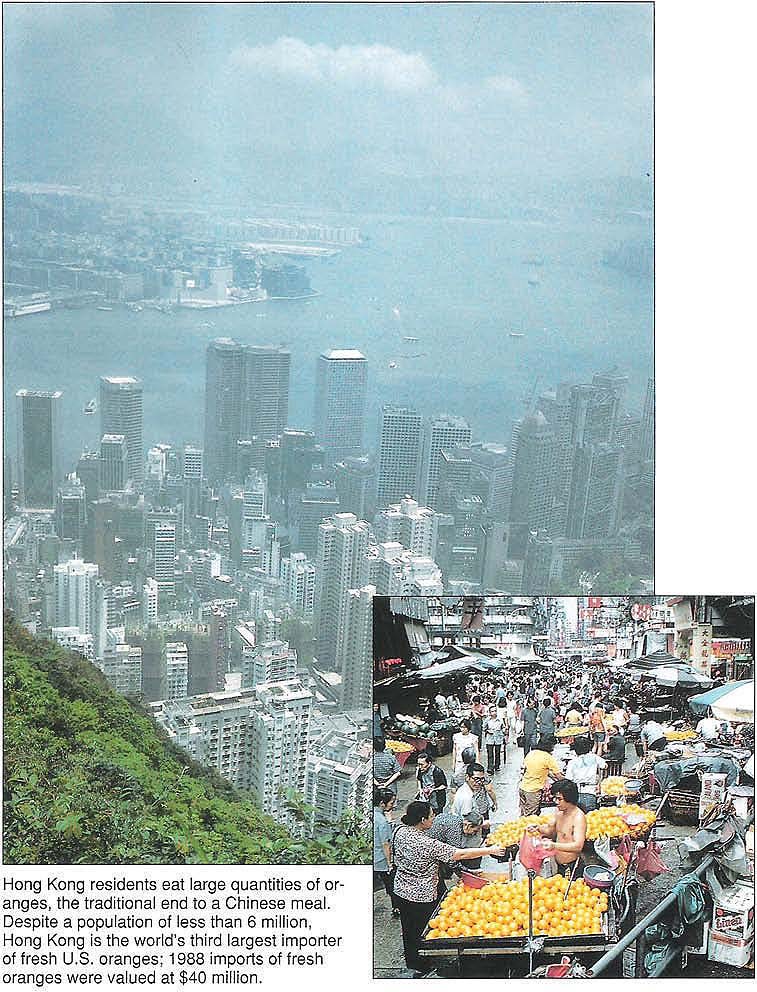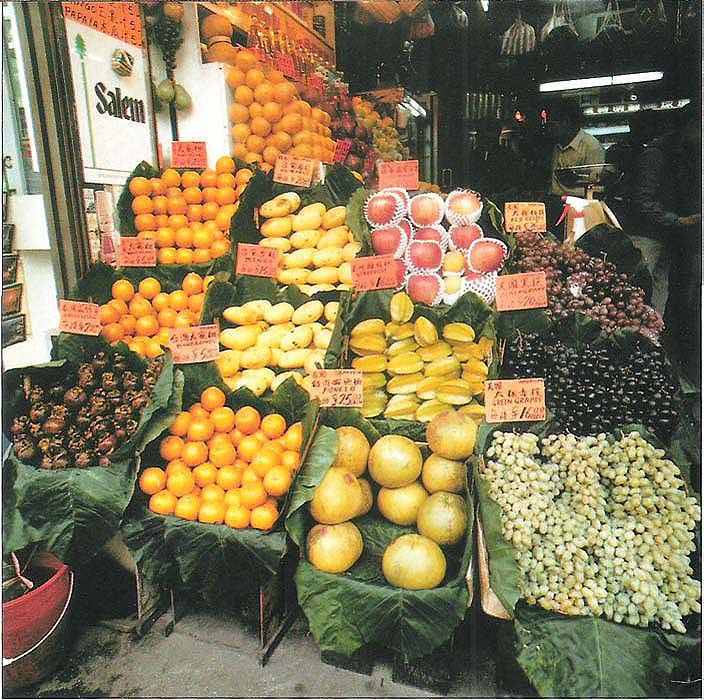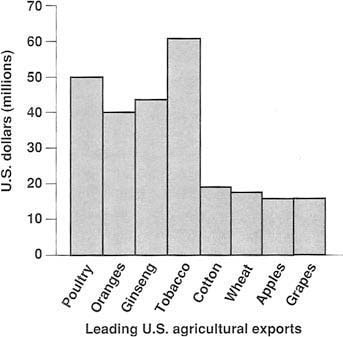All Issues
Do American farmers have a future in the Hong Kong market?
Publication Information
California Agriculture 45(5):27-28.
Published September 01, 1991
PDF | Citation | Permissions
Abstract
Hong Kong has virtually no import barriers against food imports and is an important market for American farm products. It currently imports 20% of the United States' fruit and vegetable exports — and more than half of those are produced in California. However, the situation is likely to change when the People's Republic of China regains control over Hong Kong in 1997. This article suggests that mainland China poses a major threat to the U.S. market share in Hong Kong; it also questions Hong Kong's future participation in international food markets.
Full text
Hong Kong residents eat large quantities of oranges, the traditional end to a Chinese meal. Despite a population of less than 6 million, Hong Kong is the world's third largest importer of fresh U.S. oranges; 1988 imports of fresh oranges were valued at $40 million.
The rapidly approaching transfer to Chinese rule is causing much political and economic uncertainty in Hong Kong. This article discusses the current importance of the Hong Kong market to U.S. and California agriculture and highlights the main characteristics of Hong Kong's food imports. It then evaluates potential implications for American farmers of the Chinese and British agreement to allow China to recover Hong Kong in 1997. Hong Kong is one of the most important markets for U.S. agriculture and it is also a market that is much at risk of slowly disappearing after 1997.
Dependence on food imports
Hong Kong will cease to be a British colony in July 1997 when Britain's lease expires and Hong Kong reverts back to China. Hong Kong was originally part of China during ancient times. It was first occupied by Britain during the Opium War of 1840. The British decision to give the colony back to communist China will undoubtedly have important implications for the world trading environment because Hong Kong is not only a major financial center but also is the 11th largest trading economy in the world. It actually ranks larger than China as a trading economy.
Hong Kong is physically small (622 mi2 or 1000 km2) and densely populated - with close to 6 million population. Only 9% of the territory's land is used for agricultural production, which consists mainly of vegetables, poultry, pigs and fishing. The colony is highly dependent on the rest of the world for its raw material imports, including food. The American farmer plays an important role in supplying this high-value food market. Many exports from the United States (especially fruits and vegetables) are air freighted across the Pacific in order to reach Hong Kong consumers within days of harvest in America. This is one of the few truly “commercial” markets left available to American farmers. Hong Kong is a market that is not dependent on generous U.S. export subsidies and it is one that pays the American exporter in a convertible currency without the need for subsidized credit guarantees. Hong Kong importers still buy the old fashioned way!
Display of fresh fruit and vegetables in a Hong Kong shop. The produce has been imported from the U.S., Thailand, Taiwan, Singapore and the Phillipines.
The largest supplier of agricultural products to Hong Kong is the People's Republic of China (PRO with 42% of the market. The United States is second, with 13% of the market. The PRC and the United States compete head-on because they export similar products to Hong Kong, including poultry, fruits, vegetables, rice, and nuts. The food produced in the PRC is generally of inferior quality to that produced in America because the marketing system in the PRC does not provide an incentive for its farmers to produce high-quality products. Of course, this could change with further economic reform in China, and China could soon be exporting higher quality food. In monetary terms, Hong Kong imports over $600 million in agricultural products from the United States every year. It is the fifth largest Asian market for United States food exports, behind Japan, Korea, Taiwan and the PRC.
As shown in figure 1, leading exports from the United States to Hong Kong are poultry, tobacco, oranges and ginseng. The United States is a large supplier of fresh fruit to Hong Kong, which imports 20% of all fruits and vegetables exported from the United States. Hong Kong is the third largest market for U.S. oranges and the fourth largest for grapes. It is among the top four importers of U.S. prunes and plums, melons, tomatoes, cabbages, celery, lettuce, peppers, apples, cherries and onions. In addition, it is growing in importance as a market for California wine. Most of the American fruits and vegetables shipped to Hong Kong also originate in California. In fact, over one-half of U.S. agricultural exports to Hong Kong are produced in California.
Implications of the 1997 agreement
The agreement between Britain and China, called the Basic Law, was officially adopted in April 1990. It preserves the economic status quo for 50 years and grants Hong Kong the status of Special Administrative Region (SAR) of China. It is agreed that Hong Kong will be allowed to participate independently in international organizations (it has been a separate member of the General Agreement on Tariffs and Trade since 1986, and this status will continue after 1997). Hong Kong will continue to function as an international financial center with a freely convertible currency and free movement of capital. In addition, the agreement stipulates that Hong Kong will continue as a free port and customs area.
If China adheres to this agreement then certainly American farmers will not lose the Hong Kong market overnight. Yet even under the agreement, they could lose market share to China if farmers there are given incentives to improve the quality of their fruits, vegetables, and meats in order to compete with the United States as a supplier to Hong Kong. Mainland China is only a short distance from the Hong Kong food markets. If the Chinese can improve the quality of their product, they could probably match the demand in Hong Kong at a price below that at which American products are currently supplied. This may happen in China if the economic reforms begun in 1979 are pushed beyond the point reached by June 1989. Unfortunately, we do not have enough information to say with certainty whether or not China will be able to export high-quality food to Hong Kong. Agronomically it should not present a large problem. The biggest hurdles are proper incentives and an adequate infrastructure.
After 1997, it may actually be Hong Kong entrepreneurs themselves who develop higher quality food products in China for sale in Hong Kong. They would employ mainland farmers if given the nod from the central government in Beijing. Another distinct possibility is the development of food processing on the mainland by Hong Kong firms. In fact, at present an estimated 2 million workers in mainland China work for Hong Kong bosses in light manufacturing. This is over twice the size of the work force in Hong Kong!
It would not be too surprising if Beijing decided to ignore certain details of the Basic Law and to prohibit the importation of high-valued foods from the United States. The judicious use of foreign exchange controls has worked wonders for other Asian nations (e.g., Korea). Rather than spend hard currency to airfreight fruits and vegetables from California, the Beijing government may decide to supply Hong Kong consumers with Chinese fruits and vegetables.







